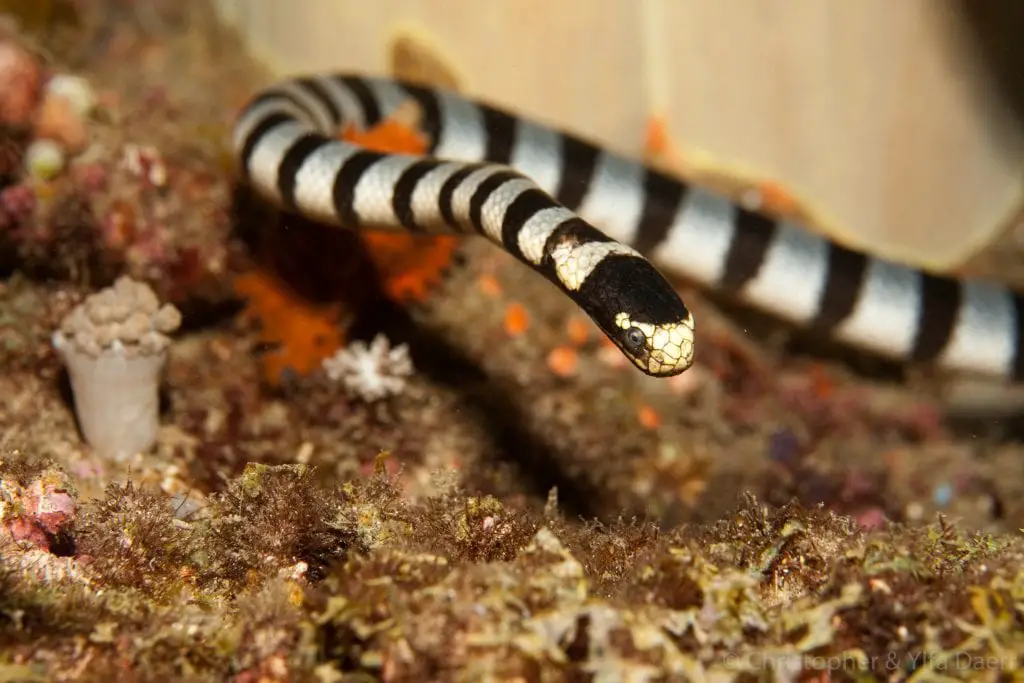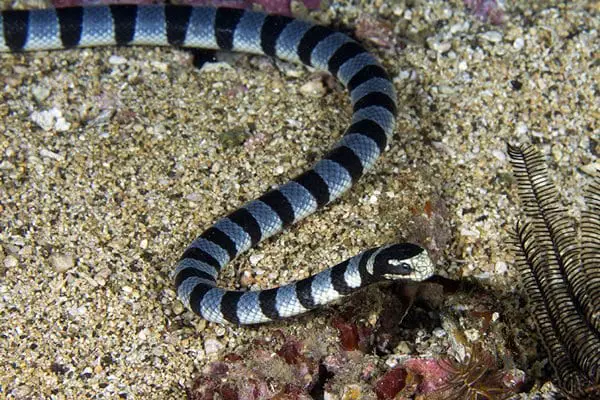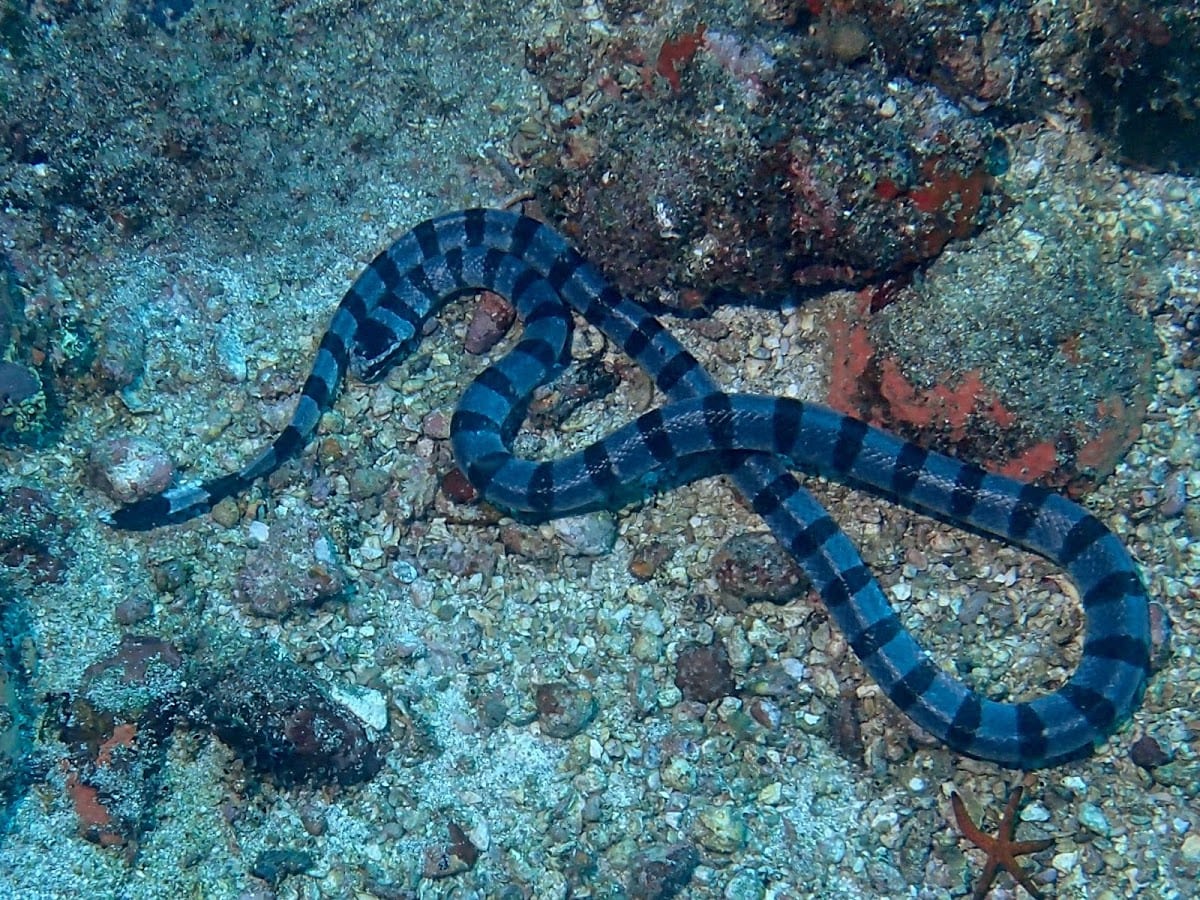Scientific Facts
| Common Name | Yellow Lipped Sea Krait |
| Scientific Name | Laticauda Colubrina |
| Origin | Eastern Indian, western Pacific oceans, Southeast Asia, Sri Lanka, Japan, New Guinea, And the Philippines |
| Habitat | Sea: Warm, shallow seas along the coral reefsLand: Low hanging trees and in the sand |
| Diet | small fish such as gobies and eels |
| Size and Weight | Females: 150cm; 1,800gramsMales: 700-100cm; 600 grams |
| Life Span | Up to 10 years in captivity |
Physical Appearance

Laticauda Colubrina is also called as banded sea krait or yellow lipped sea krait due to having a yellow upper lip in which the color yellow extends throughout the eyes and side of the head. The snake has a smooth, scaled black-striped cylindrical body with a shade of bluish-gray and a yellowish belly. Similar to other kraits, it also has a flattened body, nostrils closed to the sides of its snout, and a paddle-shaped tail that enhances their swimming capability.
The tail and the head of this snake are also seen to be similar in which it protects and helps them to fool its predator. According to some researches, these kinds of traits can help them to develop their defense strategy when they are searching for their prey. They are described as a cobra living in the water because of their strength and venom.
Where it is Seen?
Banded sea kraits are typically found along the coast side of the eastern Indian and western Pacific oceans. The distribution of these snakes is found to the coastal waters of southeast Asia, Sri Lanka, Japan, New Guinea, And the Philippines.
Habitat
Banded sea kraits usually inhabit through warm, shallow seas along the coral reefs and mangroves where their prey usually resides. They also have the ability to climb the trees, that is why you can usually see them on the trees near the bodies of water or in the island trees. In addition, these snakes usually spend their lives in the depths of the ocean, while half of the percent they like to spend their life on rocky shores in order for them to digest shed their skin, court, mate, and lay eggs.
Behavior and Temperament
Most of the activity of these snakes usually happens at night, but they are not identified as any other snakes as nocturnal because their activities at night are not frequent. At day time, they often go to the land in order to be exposed to warmth and light; that is why they could often be seen by humans. This kind of snake species find their prey underwaters, but they go to the land in order to rest, digest, and reproduce.
Banded sea kraits have neurotoxic venom wherein they use it for hunting their prey. In addition, this snake’s venom is said to be ten times more potent and could be caused paralysis, hypertension, and even death, but they are characterized as nonaggressive snakes, and they only attack once they were being cornered and threatened by the humans. Despite having a powerful venom, they usually preyed upon large varieties of fishes such as sharks, and birds like sea eagles. Hence, the similarities of their heads and their tail can help them fool these predators sometimes.
They also have the tendency to play dead if a predator tends to grab them, so if humans see that this snake is just lying on the ground not moving, don’t pick it up immediately because if they are just playing dead, they might aggressively bite you with their poison. If it so happens that you see them in the corals while having snorkeling or scuba diving, just don’t go near them because they might perceive you as their predator.
Diet
The primary food of the banded sea kraits are eels, but they also feed on small fishes such as gobies. They catch and paralyze their prey through their powerful venom and swallow them whole. Furthermore, these snakes tend to exhibit different behaviors in hunting due to their sexes. Males tend to hunt smaller eels, which is only found in shallow water where they can only survive, while females hunt larger eels, which is usually found in much deeper water. Hence, males tend to hunt more eels than females, which only have one prey per hunt.
Size and Weight
Males and Females banded sea kraits vary on sizes and weights depending on their nourishment. Since it is said that females feed on larger species of eel, they are typically larger and longer than males who only feed on smaller eels. The average length of females’ snake is about 150 cm with a weight of about 1,800 grams than males, which are only 75 to 100 cm in length and 600 grams on average.
Life Span
The maximum lifespan of banded sea kraits is said to be unknown in the wild, but there is a captive banded sea krait that lived for about 10 years. Some researchers have concluded that young sea snakes generally exhibit a high chance and rate of mortality.
Breeding and Reproduction
Females reach sexual maturity from 24 months while males reach their sexual maturity at about 18 months. This kind of snakes likely goes to the land for courtship, mating, and breeding. Unlike sea snakes who bear their young in the water, the banded sea krait likely to lay eggs on land, usually on the rocks. It said that females could lay 4- 20 eggs. These types of sea snakes are oviparous. They return to land to mate and lay eggs. Mating occurs in the months of September to December, but there are places, especially in a more tropical country wherein they do not have a certain period for breeding.
Males chase the larger, slower females and entwine around her. The males rhythmically contract to produce what are called caudocephalic waves. The duration of their copulation takes about two hours, but the mass of snakes may remain entwined for several days. Females deposit up to 10 eggs in a crevice on the land. Only two nests have ever been discovered, so little is known about how the hatchlings find their way to the water. The lifespan of the banded sea krait is unknown.
Shedding
Like other snakes, banded sea krait also shed regularly once they reach maturity. In shedding its skin, they usually rub their lips in the coral or hard substrate in order to unleash it. This skin shedding helps them to rid themselves of marine organisms like barnacles or algae. These snakes usually shed their skin every 2-6 weeks. During their shedding process, these banded sea kraits lose its striped body and turn entirely into the black in order for them to deal with water pollution. In captivity, expect to observe some unusual changes in your snake a couple of days before shedding.
Common Disease /Illnesses
Blister Disease
This kind of disease is actually seen along with the snake’s scales. This disease of a snake usually occurs in an unsanitary place that is much exposed to wet or damp housing in which it becomes a breeding ground for bacteria and fungal infestations. Most commonly, this disease can make the snake’s skin to have septicemia, which is usually fatal.
Ensuring that the environment of these kinds of snakes is clean, especially if it’s not exposed to too much damp substrate, can help avoid this kind of disease to the snakes. Once you noticed that your snake has blisters, you must go and check for a veterinarian in order to give your snake a first aid.
Anorexia
This disorder is also experienced by snakes, especially when the snakes tend to refuse the food. There possible reasons why they tend to refuse the food is, maybe their bodies can’t adapt to a cold environment, especially during the winter season, where they usually hibernate. In addition, snakes lose their appetite for food when they are about to shed. This kind of disorder can cause their life span captivity to de difficult to maintain, which results in them to die in a short time.
Hence, if you noticed that your snake doesn’t like to eat for a couple of days, it’s something serious that needs to be prevented. To be able to deal with this kind of disorder, you must go and see the veterinarian for your snakes to be treated.
Mouth Rot
This happens to the mouth of the snake, specifically if its gums are destroyed and it’s infected by the bacteria. There was an indication in knowing the condition of the mouth of your snake if it’s mild or severe. You can tell that it’s mild and can be treated if the mouth of the snake is opened while it is already severe if the jaws of the snake are already not aligned due to mucous membranes and swollen mouth. In addition, a severe stage happens when the esophagus of the snake is already infected, which causes the snake to not be able to swallow its food.
Parasites Infestations
This occurs when the housing of your snakes has a small hole where parasites can enter. In that case, there is a need to choose better housing for your snakes that are totally secure that the air can enter except for parasites. These parasites, such as tapeworms, mites, and roundworms, occur in an unhygienic environment and can be transmitted if you are handling your snake with dirty hands. Proper cleaning of the tank of your snakes and bathing them regularly can help prevent this.
Pneumonia and respiratory issues
The snakes which are exposed in a damp environment leads them to have respiratory issues. This kind of illness usually happens due to the unstable temperature of the tank of the snakes. This illness can be said to be fatal because the passageway of the air is being blocked from their nasal, which leads the snakes to have difficulty in breathing. Most likely, snakes can suffer Pneumonia and respiratory issues if your snake does not have enough immunity to resist bacterial infections and changing temperatures.
Regurgitation
Regurgitation happened when it happened that your snakes vomit the food that they eat . This is due in having difficulty in digesting it most, especially when the snake is suffering due to health condition. Having that condition on the snake can allow them to have difficulty in swallowing the foods that are feathery and hairy. This happens to the snakes if they are fed in a wrong time or schedule; that is why it is important to feed them to the right pattern or schedule to prevent this kind of illness.
Egg binding
This disease usually occurs on a female snake, especially during the birth process. This happens when the snake can’t release the egg mainly because their egg is commonly big. Sometimes, there are reported cases wherein the snake’s eggs can be stocked to their sepsis that can cause infections and may lead to death.
Preventing Illnesses
Preventing illnesses or diseases can keep your snakes to be healthy. In order to prevent your snakes from illnesses, you must always give them proper attention for you to be able to know their behavior and in order for you to be aware if they are healthy or not. Giving them proper attention includes making sure that their environment is always clean, feeding them in the right schedule, and taking them for a bath regularly.
If you already noticed that your snakes do not behave properly or there’s something wrong with how they behave, it is advisable for you to take your snake to the veterinarian in order to know the cause and effect of their unpredictable behavior and so as to give them a possible cure. With that, you can be able to reduce or prevent illnesses in your snakes.

Availability-Where to Get One?
This kind of snakes can be seen in the aquatic pet stores in which they are already tamed by the breeders and is also able to adapt to changes in climate or temperatures. It is not advisable to take them directly into captivity because the wilds tend to be more aggressive. If these types of snakes are not available in your local pet store, you may search on the internet through different pet trades or from personal snake collectors.
Captive Breeding
Banded Sea Kraits are not complicated for captivity as long as their housing is wide, large, and shallow enough for them to swim. Also, they are said to be not so aggressive unless threatened, that is why they are really good to be taken in captivity as a pet. However, those who have sufficient knowledge of how this snake behaves ate the ones applicable to take good care of this reptile since they hold a venom. They are not a common pet snake to be domesticated, but they are usually seen in the zoo
How to Care Reptile as a Pet?
Housing
Banded sea kraits are quite lengthy; it is advisable to provide them a terrarium that has at least 20-gallon capacity just enough for you to provide them a land and water area. The water area should be at least 70% of the total space since they spend most of their time in the water, the land or dry area will only serve as their basking area. It is advisable to clean their housing at least twice a month to avoid different kinds of diseases or illnesses.
Substrate and Accessories
For the water area, the applicable substrate to be used is fine or rocky sand, while for the dry area, you may use plain fine sand. The water area should be warm and salty, and it should be equipped with plants, rocks, and corals that serve as their main habitat in captivity. The land or dry area should consist of a branch, logs, and rocks where they can lay their bodies to bask.
Light and temperature
Make sure to maintain a water temperature of about 80 degrees Fahrenheit in the water area while 80 and 90 degrees Fahrenheit in the land area. They prefer warm temperatures, so if the temperature at your place drops below 80 degrees, make sure to provide heaters. The land area should also be equipped with an LED light or incandescent light for an effective digestive tool for them.
Food
In captivity, they are given eels and different kinds of fish. There are some attempts to give them rodents, but it is always failing because it is not appetizing food for them. They usually eat when their prey is in the water, so in feeding them, place the food in the water area. Give them foods at least three times a week; make sure not to overfeed them to avoid overfeeding and obesity.
Handling
Because of the venom that they have, it is advisable to handle them if you have the knowledge in doing so. They have an unusual temperament that is unpredictable. In captivity, make sure that they stay in a comfortable housing like that of their habitat in their natural environment so as not to trigger any aggressive behavior.
Conservation Status
Banded Sea Krait is not included in the list of endangered species, but they are also vulnerable to hunting because they also stay on the land. The different threats to their population are the effects of pollution on coastal areas that destroy coral reef where they live, overfishing that reduces their food, and the destruction of mangrove swamps where they stay when they are in the land. In Thailand, there is wide hunting for these species because they are commonly made into food or medicine. There are restaurants that offer snakes dishes as their specialty.
FAQ Section
How poisonous a yellow lipped sea krait is?
The venom found in the yellow-lipped sea krait is 12 times more poisonous than a rattlesnake where they can paralyze their prey in just a single bite. Their venom tends to be stronger like that of a cobra.
Can banded sea krait kill humans?
This snake does not see humans as prey, but they can bite when threatened. If that happens, their venom can kill humans because of the level of poison it posses.
Can a sea snake bite you underwater?
They can definitely bite whether on land or at sea, but they will not attack unless they are provoked.
Do yellow lipped sea krait snakes lay eggs?
Yellow lipped sea kraits, as well as other sea snakes, are oviparous or they lay eggs. They do not give their eggs parental care. In fact, after laying their eggs, they go back to the water immediately.
Are yellow lipped sea kraits aggressive?
These snakes are nocturnal, that is why they are usually active and more aggressive in the early morning from late evening. During the day, they tend to be shy, unaggressive, and docile.
What do you do if a yellow lipped sea snake bites you?
The first aid that you need to do is to apply pressure over the bite, may it be a bandage or a piece of cloth. If you are wearing jeans, make sure not to take it off so as not to spread the venom easily into. The bloodstream and as much as possible, keep the bitten part still.
Do people eat sea snakes?
In some countries such as in Thailand, these types of snakes are consumed as part of their cultures, may it be as a delicacy, drink, soup or made into traditional medicine. There are over 80 tons of snakes that are often taken from the Gulf to be consumed by humans.
Do sea snakes drink water?
Like other animals and humans, this snake species, do not drink salt water. They only drink freshwater from other bodies of water or from the rain.
Can a yellow lipped sea krait drown?
The only way for a yellow lipped sea krait to drown is if they swim non-stop, exhausting their energy. They do not have gills; that is why they should stay in some in a shallow part of the sea until where the divers are allowed to stay.



